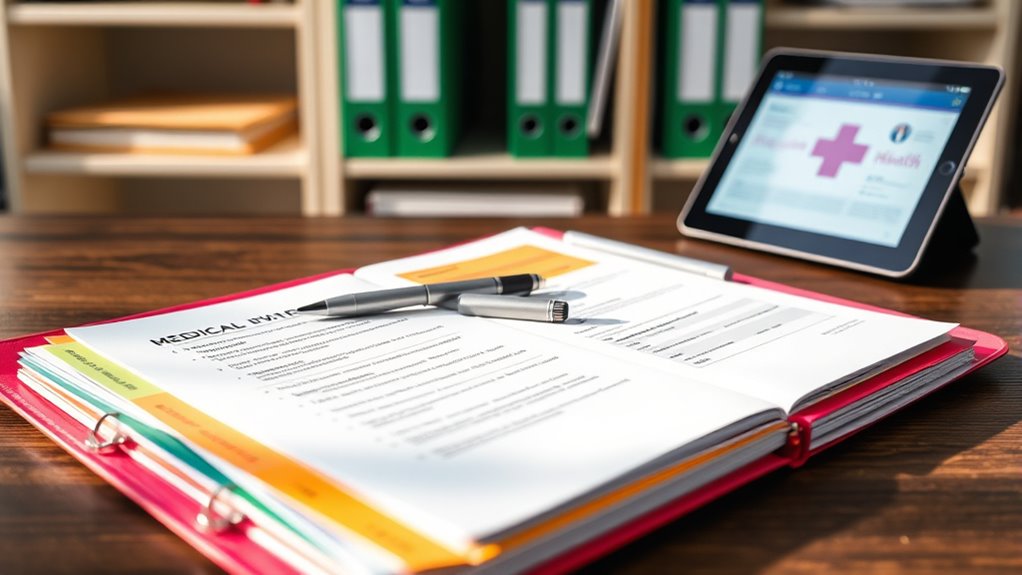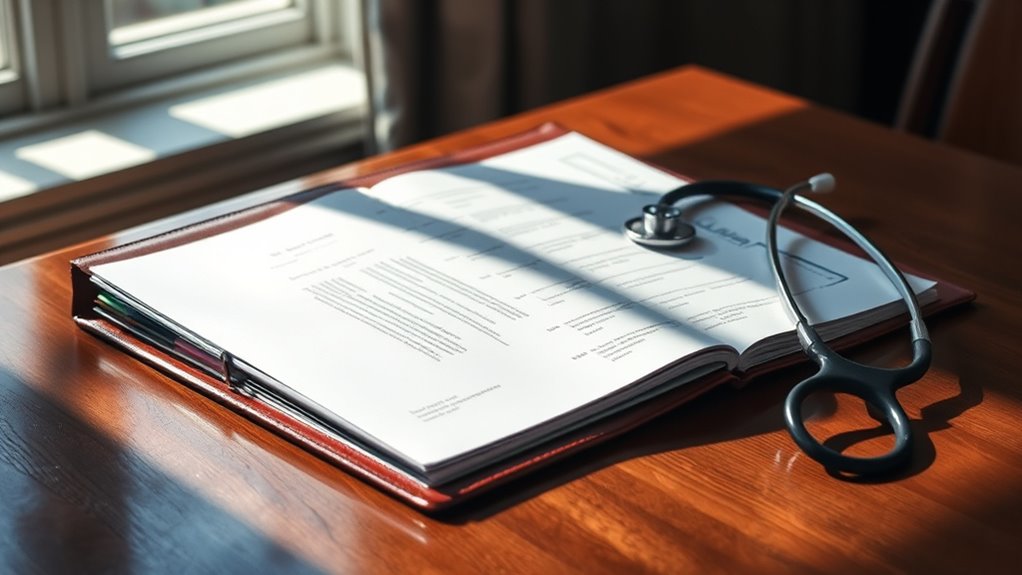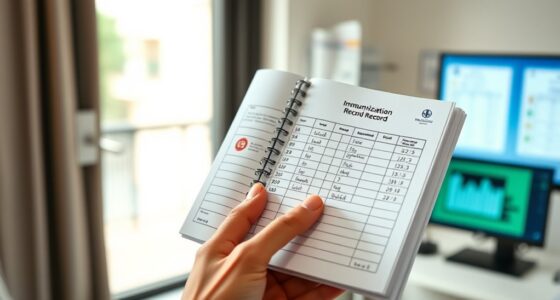Creating a personal medical records binder helps you stay organized and prepared by collecting all your health info in one spot. Include sections for medication lists, emergency contacts, healthcare providers, allergies, test results, and insurance cards. Keep the binder in a consistent, accessible place, and consider digital backups for added security. By maintaining this binder, you’ll be ready for emergencies and ensure clear communication with your healthcare team—learning more can make this even easier.
Key Takeaways
- Gather all health documents, including test results, insurance cards, and medical history, and organize them into clearly labeled sections.
- Create a medication tracking list with names, dosages, prescribing doctors, and update regularly for accuracy.
- Include emergency contacts, healthcare providers, and specialists with full details to ensure quick access during emergencies.
- Store copies of important documents digitally for backup and easy sharing, ensuring secure online or portable device storage.
- Keep the physical binder in a consistent, accessible location to facilitate quick retrieval and effective communication with healthcare providers.

Having an personal medical records binder is essential for staying organized and ensuring you have quick access to important health information when you need it most. This binder serves as a centralized hub for all your medical details, making it easier to communicate with healthcare providers, manage ongoing treatments, and respond effectively in emergencies. One of the first things you should include is a medication tracking section. Keeping an up-to-date list of all your medications—prescriptions, over-the-counter drugs, supplements, and dosages—helps prevent dangerous drug interactions and guarantees your providers have accurate information. Regularly updating this list is crucial, especially if your medications change or doses are adjusted. Include details like the medication name, dosage, frequency, and prescribing doctor. This not only streamlines medical visits but also provides clarity in urgent situations where quick decisions are necessary.
Equally important is maintaining a current list of emergency contacts. This section should feature at least one primary person you trust, such as a family member or close friend, along with alternate contacts. Write down their full names, phone numbers, and relationship to you. Having this information readily available can save precious time if you’re unable to communicate during a medical emergency. It’s also wise to include your primary care physician, specialists, and any other healthcare providers involved in your care. When emergency contacts are easily accessible, responders and medical staff can quickly notify loved ones and gather vital information about your health history.
Beyond medication tracking and emergency contacts, your binder should include your medical history, allergies, current diagnoses, and recent test results. Carry a copy of your insurance cards and any advance directives, such as healthcare power of attorney or living will. Organize these sections with clear labels and keep the binder in a consistent, accessible place at home. Consider creating digital copies as backups stored securely online or on a portable device, so you’re never without vital information, even if the physical binder is misplaced. Additionally, understanding the importance of contrast ratio in your medical records can help you better interpret diagnostic images and test results, leading to more informed healthcare decisions.
Frequently Asked Questions
How Often Should I Update My Medical Records Binder?
You should update your medical records binder regularly to guarantee it’s current and accurate. A good binder maintenance schedule involves reviewing and adding new information at least every six months, or after any medical appointment, test, or treatment. This helps with medical record retention and ensures you’re prepared for emergencies or doctor visits. Staying consistent with updates keeps your records reliable and easy to access when needed.
What Should I Do if I Lose My Medical Records?
Losing your medical records is like misplacing a treasure chest. First, contact your healthcare providers to request copies of your records. Use digital storage options for backups, ensuring record security with strong passwords and encryption. Keep copies in a safe, easily accessible location. Regularly updating your digital files helps prevent future loss. Staying organized means you’ll always have your health info when you need it most, with peace of mind.
Can I Include Digital Copies Along With Physical Documents?
You can absolutely include digital copies along with physical documents in your personal medical records binder. Using digital backups makes it easier to access your information quickly and share it if needed. Just be mindful of privacy concerns—store digital files securely with strong passwords and encryption. This way, you safeguard your sensitive medical information while enjoying the convenience of both physical and electronic records.
How Do I Organize Records for Multiple Family Members?
Imagine your records are a bustling train station, with each family member’s journey needing clear tracks. To organize, create separate sections for each family member, using family member categories and record labeling techniques. Label folders with names, dates, and conditions, and use color codes for quick identification. This way, you keep everyone’s health on track, ensuring easy access and smooth journeys through medical history.
Are There Any Legal Considerations for Storing Medical Records?
When storing medical records, you should consider confidentiality concerns and legal document standards. Guarantee that your records are kept securely to protect sensitive information and comply with privacy laws like HIPAA. Avoid sharing your records with unauthorized individuals, and keep digital copies encrypted if stored electronically. Regularly update and organize your documents to meet legal requirements, making sure they’re accessible when needed without risking privacy breaches.
Conclusion
By organizing your medical records in a binder, you’re taking control of your health journey. Keep everything up-to-date and easily accessible for emergencies or appointments. Remember, “A stitch in time saves nine”—being prepared now can save you future headaches. Stay proactive about your health by maintaining your records, and you’ll feel more confident and in charge every step of the way. Your future self will thank you for the effort you put in today.







